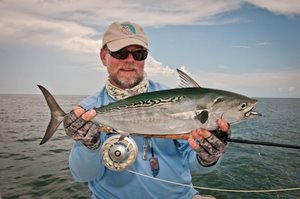By TERRY TOMALIN
Originally published November 26, 1999
© St. Petersburg Times
TAMPA BAY — school of marauding bonito ripped through a pod of baitfish at the edge of the channel. The oil slick from the wounded sardines drifted with the outgoing tide, attracting seabirds from farther than the eye could see.
Randy Rochelle watched the feeding frenzy for a moment, then went back to the business of rigging his grouper rods.
“Those bonito have been here all week,” he said. “You’ll see everything out here.”
The little tuna, a common offshore fish, had followed the 40-mile long, 43-foot deep shipping channel straight to the Sunshine Skyway.
Any other day, Rochelle might have broken out a lightweight spinning rod and had some fun with the thick-bodied fighters. But on this cool November morning, he had a different prey in mind.
“There are little rock piles all around the edge of the shipping channel,” he explained. “They all hold grouper, but catching them is another question.”
Rochelle, a St. Petersburg guide who spends most of his time offshore, began fishing for gags at the mouth of the bay more out of convenience than necessity.
“You can leave the boat ramp and 15 minutes later you are catching fish,” he said. “If you wanted to do the same thing offshore, it would take hours.”
Like most local fishermen, Rochelle had heard the stories about the old days when you could head out to the channel in a 16-foot skiff, catch 400 pounds of grouper and still make it home for dinner.
With the average depth of the bay just 12 feet, many big, ocean-dwelling predators such as bonito, king mackerel and grouper use the shipping channel as a highway of sorts, a safe route to shallow water and the food sources drifting in off the flats. These fish will attack whatever they can, jigs, plugs, spoons, live or cut bait.
“Sometimes it is hot, sometimes it is slow,” Rochelle said. “The trick is having a good bottom machine so you can see the spots you are fishing.”
Grouper, like most predators, seek structure, such as artificial reefs, rock piles, even the rocky outcroppings and limestone ledges that line the shipping channel.
The area around the Sunshine Skyway bridge is particularly productive because of the old bridge rubble.
“You’ll hit a little ridge now and then and get hung up,” Rochelle said. “But then you just circle back around and you will usually get your gear back.”
About 20 minutes after he dropped his first artificial bait to 23 feet (trolled behind a downrigger), Rochelle caught his first fish, an 18-inch black grouper he released.
“You can actually see the fish on the bottom machine,” he said. “If they come up off the bottom, start cranking because they’ll take you back down into the rocks, then that is it. You’ve got to start all over again.”
Many anglers who troll the shipping channel make the mistake — the big mistake — of actually trolling down the middle of the channel. The freighters and tankers who use the channel can’t stop or turn to avoid recreational anglers.
The key is to find the edge of the channel, or better yet some natural hard bottom or one of the hundreds of rock piles that litter the area.
“If you troll long enough, you’ll catch legal-sized fish,” Rochelle said. “But you have to be close to the bottom.”
The big boys often take a little more coaxing to lure them out of their hiding spots.
“After I work the artificials for a while, I’ll often mark a spot, then drift over it with cut bait,” Rochelle said. “It usually works for bigger fish.”
Rochelle circled a spot four or five times before finally locating the small wreck, which was no bigger than his 28-foot boat, he had been seeking.
Then he handed a rod to each of his anglers and put the engine in neutral.
“If you feel a tug, start reeling,” he said. “You might only get one chance.”
The first pass produced no fish, just a couple of broken rigs.
But on the second drift, a grouper grabbed the dead sardine and bent the stout rod toward the water.
“This is a big fish,” Rochelle said as he battled the fish to the surface. “Get the net. No, get the gaff.”
With the fish safely on board, Rochelle looked for a ruler. “Thirty-six inches and 20 pounds, I would guess,” he said.
Then he looked to see if anybody had seen him catch this monster on his secret spot in the shadow of the Skyway.
The coast was clear. So he reeled in his lines and headed home. “We’ll leave some for next time.” Main Shipping Channel attracts sea life
Tampa Bay is relatively shallow, averaging just 12 feet deep. But the Main Shipping Channel, 43 feet deep and 40 miles long, attracts a variety of ocean dwellers, including king mackerel and gag grouper. The channel markers are labeled in descending order, offshore to inshore. You may have heard a captain report that “the kings are hitting at markers five and six,” which means they are feeding well offshore. While many anglers troll directly in the Main Shipping Channel, it is prudent to keep an eye on the freighters and tankers. These large ships are moving faster than they appear and take miles to stop. So exercise caution.
- Jay Mastry - March 26, 2024
- Captains Corner, Gorta - March 23, 2024
- Dave Zalewski - March 12, 2024











